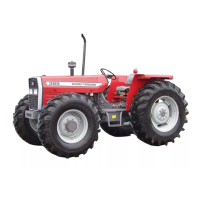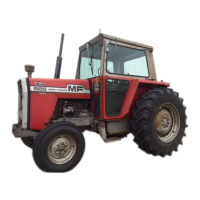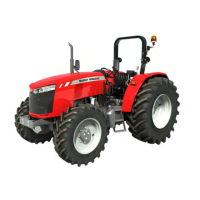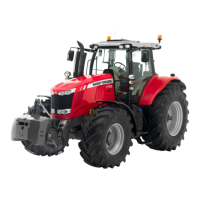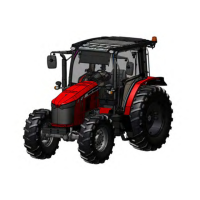MASSEY.FERGUSON
TECUMSEH
ENG''VES
MODEL
H7O
GROUP
O_SECTION
V-PART
8
NOTE:
'Ihe
exhaust
oalae ancl the intake ariloe
ore not
identical. The
exhaust aalDe, subject to
the
high exhaust
heat, is stellite-faced,
dia-
chrome steel
and is marked with an
"EX"
to
identifu
it. Make
sure this aalae is lapped
and
assembletl
to the exhaust port.
b. Lift
valve from
seat every
eight or ten
strokes to
keep
compound
equalized on surface
of valve
seat.
c. Continue
valve lapping operation
until a
smooth
surface
is
attained
on
both
valve and seat.
d. When
a
good
surface is
attained,
wash
all
parts
with
solvent
to remove
all
traces
of
lapping com-
pound;
dry parts
thoroughly.
NOTE:
Valoes
u;ith ooersized stems are aDail-
able.
Directions
for
reboring
the aalae
guide,s
in the
cglinder block are
found
in
"Reboring
Valoe
Guicles".
7. Valve
grinding
changes the valve lifter clearance.
After
grinding
valves, check
valve
lifter clearance as
follows:
a. Rotate
crankshaft
until cams on camshaft
are out
of engagement
with
valve
lifters.
b. Insert
valves
in their
guides
nnd hold valves
firmly
on
seats.
c.
Check clearance
between bottom
of
each valve
stem
and its
valve lifter with feeler
gauge.
The
clearance
should be .0l0-inch.
Grind
off valve
stem
in
a valve resurfacing
machine set to
grind
a
perfectly
square face.
Grind
stem
until
proper
clearance
is attained.
8. Install
valves as follor.vs:
a. Position
spring and
upper and
lorver
spring
caps
under
guide
for
valve being installed.
b. Install
valve in
its
guide,
making
sure that valve
marked
"EX"
is inserted in
exhaust
port.
The
stem
must pass
through
the spring
and
the spring cirps.
c. Insert
blade
of screwdriver under lorver valve
spring
cap
and
pry
spring.
d.
Insert pin
through hole in stem with long-nosed
pliers.
Make sure pin is properly
seated under
lower
spring
cap.
REGRINDING
VALVE
SEATS
Valve seats
need regrinding
only if they
are
pitted or
scored.
If there
are no pits
or scores,
lapping
in valves
will
provide
a
proper
valve
seat. Valve
seats are
perrn-
anently installed
and are not replaceable.
Regrind
the
valve seats
as follows:
l.
Use
a
grinding
stone
or a valve seat
reseater which
is
used to provide
the proper
angle and seal face dimen-
sions. Check
"Specifications"
for
the
proper
dimensions.
2.
If the
seat is
over
3/6a-inch
wide
after
grinding,
use a l5o
stone
or
cutter to
narrow
the face to
proper
dimension.
2
3.
Inspect seats to
make sure that
cutter or stone has
been held squarely
to
valve seat and that same dimen-
sion
has been held
around
entire circumference of seat.
4. Lap
valves
to reground
seats as described in
Step
No.6 of
"Valves-Grinding
and
Replacement",
REBORING
VALVE
GUIDES
Valve
guides
are
perrnanently
installed in cylinder
and are not replaceable.
However, if
guides
become
rvorn so that
excessive play
exists between
valve stem
and
valve
guide,
the
guide
can be rebored
to accom-
modate a valve rvith
a
1
/sz-inch
oversized stem. Re-
bore
valve
guides
in cylinder
as follows:
l.
Dismantle engine as
described in
Step No.
I of
"Valves-Grinding
and
Replacement".
2.
Thoroughly clean
cylinder with solvent
and
dry
completely.
3.
Ream valve
guides
with
a standard, straight-
shanked hand reamer
or lorv-speed
drill
press.
Refer
to
"Specifications"
to determine
correct valve stem
diameter.
4.
Redrill upper and lower
valve spring caps
to
ac-
commodate oversized
valve stems.
5. Reassemble
engine as described
in Step No.
B
of
"Valves-Grinding
and
Replacement", installing
valves
rvith
oversized stems in
valve
guides.
CYLINDER
COVER
l.
Drain oil
from
crankcase.
2.
Check crankshaft
end. If
rusty
or
pitted, polish
rvith
fine emery cloth.
3.
Remove
bolts
holding cylinder
cover
to cylinder.
Lightly
force sleeve
tool,
Fig.
2, into
oil seal. Lift cover
from
cylinder.
4.
Remove oil seal tool.
Remove oil seal as shown
in
Fi53.
c
f\"'"3!'i"
, ott
/
SEAI
Fig.
2
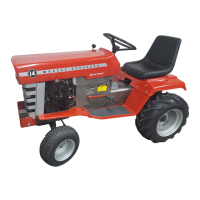
